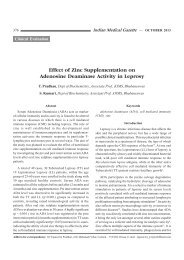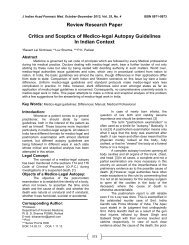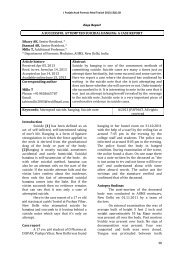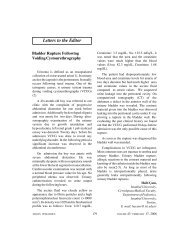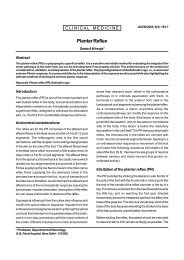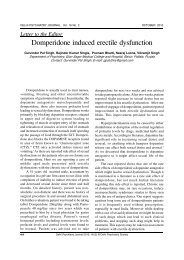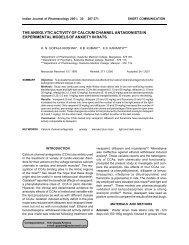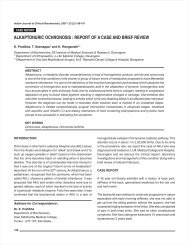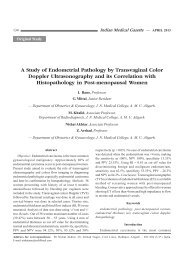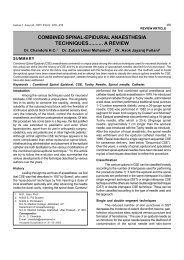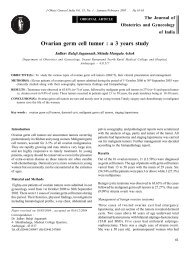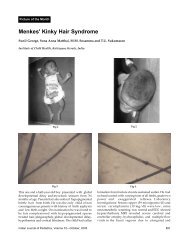The modulating effect of Garcinia Cambogia extract on - medIND
The modulating effect of Garcinia Cambogia extract on - medIND
The modulating effect of Garcinia Cambogia extract on - medIND
Create successful ePaper yourself
Turn your PDF publications into a flip-book with our unique Google optimized e-Paper software.
Indian Journal <str<strong>on</strong>g>of</str<strong>on</strong>g> Pharmacology 2001; 33: 87-91 SHORT COMMUNICATION<br />
Corresp<strong>on</strong>dence: C.S. Shyamala Devi<br />
GARCINIA CAMBOGIA AND ETHANOL INDUCED PEROXIDATION<br />
THE MODULATING EFFECT OF GARCINIA CAMBOGIA EXTRACT ON ETHANOL<br />
INDUCED PEROXIDATIVE DAMAGE IN RATS<br />
SUMMARY<br />
KEY WORDS<br />
P. MAHENDRAN, C.S. SHYAMALA DEVI<br />
Department <str<strong>on</strong>g>of</str<strong>on</strong>g> Biochemistry & Molecular Biology, University <str<strong>on</strong>g>of</str<strong>on</strong>g> Madras, Guindy Campus,<br />
Chennai - 600 025.<br />
Manuscript Received: 25.5.2000 Revised: 14.6.2000 Accepted: 13.7.2000<br />
Objective: To determine the <str<strong>on</strong>g>modulating</str<strong>on</strong>g> <str<strong>on</strong>g>effect</str<strong>on</strong>g> <str<strong>on</strong>g>of</str<strong>on</strong>g> <str<strong>on</strong>g>Garcinia</str<strong>on</strong>g> cambogia fruit <str<strong>on</strong>g>extract</str<strong>on</strong>g> <strong>on</strong> ethanol induced<br />
peroxidative damage in rats.<br />
Method: Male albino rats weighing 125 to 150g were administered ethanol (7.11g per kg body weight /<br />
day) for 45 days. Ethanol administered rats were treated c<strong>on</strong>comitantly with <str<strong>on</strong>g>Garcinia</str<strong>on</strong>g> cambogia fruit<br />
<str<strong>on</strong>g>extract</str<strong>on</strong>g> (1g/kg body weight / day) orally for 45 days. After the experimental period the antioxidant enzymes,<br />
LPO, c<strong>on</strong>jugated diene in the liver tissue, serum AST, ALT and alkaline phosphatase and lipid levels in<br />
both serum and liver tissue were estimated.<br />
Results: Co-treatment <str<strong>on</strong>g>of</str<strong>on</strong>g> the rats with <str<strong>on</strong>g>Garcinia</str<strong>on</strong>g> cambogia significantly inhibited the rise in lipid levels<br />
and also the peroxidative damage caused by ethanol, which is evident from the improved antioxidant<br />
status. <str<strong>on</strong>g>The</str<strong>on</strong>g> levels <str<strong>on</strong>g>of</str<strong>on</strong>g> serum AST, ALT and alkaline phosphatase were maintained at near normalcy in<br />
<str<strong>on</strong>g>Garcinia</str<strong>on</strong>g> cambogia treated rats.<br />
C<strong>on</strong>clusi<strong>on</strong>: <str<strong>on</strong>g>The</str<strong>on</strong>g> imbalance in lipid metabolism could be the reas<strong>on</strong> for increase in lipid peroxidati<strong>on</strong>. In<br />
our present study the treatment with <str<strong>on</strong>g>Garcinia</str<strong>on</strong>g> cambogia fruit <str<strong>on</strong>g>extract</str<strong>on</strong>g> resulted in reducti<strong>on</strong> <str<strong>on</strong>g>of</str<strong>on</strong>g> both serum<br />
and liver lipid to near normalcy. This hypolipidemic property <str<strong>on</strong>g>of</str<strong>on</strong>g> <str<strong>on</strong>g>Garcinia</str<strong>on</strong>g> cambogia in turn reduces the<br />
peroxidative damage, enhanced by ethanol.<br />
Ethanol <str<strong>on</strong>g>Garcinia</str<strong>on</strong>g> cambogia lipid peroxidati<strong>on</strong> hyperlipidemia antioxidant enzymes<br />
INTRODUCTION<br />
Liver being the major site for detoxificati<strong>on</strong> is the primary<br />
target for envir<strong>on</strong>mental or occupati<strong>on</strong>al toxic<br />
exposure 1 . <str<strong>on</strong>g>The</str<strong>on</strong>g> alcoholic liver injury appears to be<br />
generated by the <str<strong>on</strong>g>effect</str<strong>on</strong>g>s <str<strong>on</strong>g>of</str<strong>on</strong>g> ethanol metabolism and<br />
the toxic <str<strong>on</strong>g>effect</str<strong>on</strong>g>s <str<strong>on</strong>g>of</str<strong>on</strong>g> acetaldehyde which may be mediated<br />
by acetaldehyde altered proteins 2 . Chr<strong>on</strong>ic<br />
alcohol intake is known to produce hypercholesterolemia,<br />
hyperlipidemia, hypertriglyceridemia 3,4 . In<br />
chr<strong>on</strong>ic lipid accumulati<strong>on</strong> the liver cells become fibrotic<br />
and leads to impaired liver functi<strong>on</strong>. Enhanced<br />
lipid peroxidati<strong>on</strong> has been reported in hyperlipidemia<br />
5 , which is also induced by ethanol 3,4 . Ethanol<br />
increases triglycerides and cholesterol levels thus<br />
inducing imbalance in lipid metabolism in liver, heart,<br />
kidney and other organs and this could explain the<br />
reas<strong>on</strong> for the increase in lipid peroxidati<strong>on</strong> in these<br />
organs. Recently free radical induced lipid peroxidati<strong>on</strong><br />
has gained much importance because <str<strong>on</strong>g>of</str<strong>on</strong>g> its in-<br />
volvement in several pathologies 6,7 . Protecti<strong>on</strong> <str<strong>on</strong>g>of</str<strong>on</strong>g> cell<br />
membrane from lipid peroxidati<strong>on</strong> becomes a necessity<br />
to prevent, cure or delay the aforesaid patho-logies.<br />
Rind <str<strong>on</strong>g>of</str<strong>on</strong>g> the fruits <str<strong>on</strong>g>of</str<strong>on</strong>g> <str<strong>on</strong>g>Garcinia</str<strong>on</strong>g> cambogia (Gaertn.)<br />
Desr. (Clusiaceae) is an astringent and is useful in<br />
the treatment <str<strong>on</strong>g>of</str<strong>on</strong>g> ulcers, haemorrhoids, diarrhoea and<br />
dysentry 8,9 . <str<strong>on</strong>g>Garcinia</str<strong>on</strong>g> cambogia fruit <str<strong>on</strong>g>extract</str<strong>on</strong>g>, c<strong>on</strong>taining<br />
the principle organic acid, (-)-erythro-L s -<br />
hydroxycitric acid is a powerful anti-lipogenic agent 10 .<br />
<str<strong>on</strong>g>The</str<strong>on</strong>g> present study is an attempt to elucidate the<br />
antiperoxidative property <str<strong>on</strong>g>of</str<strong>on</strong>g> <str<strong>on</strong>g>Garcinia</str<strong>on</strong>g> cambogia <strong>on</strong><br />
ethanol induced peroxidative damage and its efficacy<br />
to inhibit lipid peroxidati<strong>on</strong>.<br />
MATERIALS AND METHODS<br />
Animals: Male albino rats weighing 125 to 150 g<br />
were purchased from FIPPAT, Padappai, Chennai.<br />
<str<strong>on</strong>g>The</str<strong>on</strong>g> animals were housed in plastic bottom cages
88<br />
P. MAHENDRAN AND C.S. SHYAMALA DEVI<br />
Table 1. Serum and hepatic levels <str<strong>on</strong>g>of</str<strong>on</strong>g> total cholesterol, triglycerides, free fatty acids, phospholipids, alkaline phosphatase, aspartate<br />
amino transferase (AST), alanine amino transferase (ALT) in experimental groups a .<br />
I II III IV ANOVA<br />
Parameters b C<strong>on</strong>trol Group 18% Ethanol treated <str<strong>on</strong>g>Garcinia</str<strong>on</strong>g> cambogia <str<strong>on</strong>g>Garcinia</str<strong>on</strong>g> cambogia F value*<br />
(n = 6) group (n = 6) treated group + 18% ethanol treated<br />
(n = 6) group (n = 6)<br />
Total cholesterol A 70.4 ± 1.18 113.2 ± 2.19*** 64.3 ± 1.26*** 72.2 ± 1.81*** 4.24<br />
B 4.36 ± 0.37 6.82 ± 0. 51*** 3.72 ± 0.51* 4.76 ± 0.40*** 2.88<br />
Triglycerides A 107.8 ± 2.08 156.0 ± 2.14*** 98.5 ± 2.09*** 112.9 ± 2.11*** 3.97<br />
B 4.23 ± 0.41 5.87 ± 0.50*** 3.73 ± 0.46* 4.54 ± 0.40*** 2.94<br />
FFA A 64.1 ± 1.96 115.4 ± 2.28*** 56.6 ± 1.64*** 70.8 ± 2.07*** 3.68<br />
B 11.5 ± 0.93 21.6 ± 1.67*** 9.9 ± 0.81** 13.2 ± 1.24*** 3.24<br />
Phospholipids A 115.6 ± 2.06 142.4 ± 2.17*** 110.3 ± 1.98** 126.7 ± 2.23*** 3.07<br />
B 23.1 ± 2.15 38.7 ± 1.83*** 20.6 ± 1.91* 30.4 ± 1.47*** 2.90<br />
Alkaline Phosphatase A 0.76 ± 0.05 1.57 ± 0.04*** 0.69 ± 0.04 NS 0.86 ± 0.03*** 2.78<br />
B 1.41 ± 0.04 0.88 ± 0.03*** 1.34 ± 0.05 NS 1.19 ± 0.04*** 2.91<br />
AST A 0.48 ± 0.04 0.83 ± 0.03*** 0.41 ± 0.04 NS 0.52 ± 0.04*** 2.83<br />
B 0.72 ± 0.06 0.46 ± 0.04*** 0.78 ± 0.05 NS 0.69 ± 0.05*** 2.79<br />
ALT A 0.63 ± 0.04 0.92 ± 0.04*** 0.61 ± 0.04 NS 0.58 ± 0.03*** 2.96<br />
B 1.04 ± 0.03 0.68 ± 0.02*** 1.07 ± 0.03 NS 0.93 ± 0.03*** 2.81<br />
A : Serum B : Liver. a Values are expressed as mean ± SD for 6 animals in each group.<br />
Students ‘ t ’ test: Group II vs Group I, Group III vs Group I, Group IV vs Group II. *p < 0.05; **p < 0.01; ***p < 0.001<br />
b <str<strong>on</strong>g>The</str<strong>on</strong>g> values <str<strong>on</strong>g>of</str<strong>on</strong>g> lipids in serum are expressed as mg/dl. <str<strong>on</strong>g>The</str<strong>on</strong>g> values <str<strong>on</strong>g>of</str<strong>on</strong>g> AST, ALT and ALP in serum are expressed as µkat/litre.<br />
<str<strong>on</strong>g>The</str<strong>on</strong>g> levels <str<strong>on</strong>g>of</str<strong>on</strong>g> AST and ALT in liver are expressed as µ moles <str<strong>on</strong>g>of</str<strong>on</strong>g> pyruvate liberated/sec/g protein. <str<strong>on</strong>g>The</str<strong>on</strong>g> level <str<strong>on</strong>g>of</str<strong>on</strong>g> ALP in liver is expressed<br />
as µ moles <str<strong>on</strong>g>of</str<strong>on</strong>g> phenol liberated/sec/g protein.<br />
F - test, * Significant at level <str<strong>on</strong>g>of</str<strong>on</strong>g> 5% (2.77).<br />
and allowed free access to standard laboratory chow<br />
(Hindustan Lever Foods, Bangalore, India) and water.<br />
Drug: <str<strong>on</strong>g>Garcinia</str<strong>on</strong>g> cambogia fruit <str<strong>on</strong>g>extract</str<strong>on</strong>g> was obtained<br />
from Siris Herbex, Vijayawada, India. Absolute alcohol<br />
(99%) was purchased from Anilax Chemicals,<br />
USA. All other chemicals used for the experiment<br />
were <str<strong>on</strong>g>of</str<strong>on</strong>g> analytical grade.<br />
Grouping<br />
Group I - Normal C<strong>on</strong>trol (n = 6).<br />
Group II - Rats given 18% ethanol (7.11g/kg body<br />
weight day) 5 ml/100 g body weight for<br />
45 days (n = 6).<br />
Group III - Normal rats given <str<strong>on</strong>g>Garcinia</str<strong>on</strong>g> cambogia<br />
1 g/kg body weight/day orally for 45 days<br />
(n = 6).<br />
Group IV - Rats given 18% ethanol (7.11g/kg/body<br />
weight/day) + <str<strong>on</strong>g>Garcinia</str<strong>on</strong>g> cambogia, 1 g/<br />
kg body weight/day for 45 days (n = 6).<br />
After the experimental period the overnight fasted<br />
rats were sacrificed by cervical dislocati<strong>on</strong>. Blood and<br />
tissues were collected in ice-cold c<strong>on</strong>tainers for various<br />
estimati<strong>on</strong>s.<br />
AST, ALT 11 and alkaline phosphatase 11 were estimated<br />
in the serum. SOD 12 , CAT 13 , GSH 14 , GSH-Px 15 ,<br />
GST 16 , LPO 17 and c<strong>on</strong>jugated dienes 18 were estimated<br />
in the liver tissue. Total cholesterol 19<br />
phospholipids 20,21 , triglycerides 22 FFA 23 and protein 24<br />
were estimated both in serum and tissue.
GARCINIA CAMBOGIA AND ETHANOL INDUCED PEROXIDATION<br />
Table 2. <str<strong>on</strong>g>The</str<strong>on</strong>g> level <str<strong>on</strong>g>of</str<strong>on</strong>g> lipid peroxide, c<strong>on</strong>jugated diene and activities <str<strong>on</strong>g>of</str<strong>on</strong>g> antioxidant enzymes in the liver <str<strong>on</strong>g>of</str<strong>on</strong>g> experimental groups a .<br />
I II III IV ANOVA<br />
Parameters b C<strong>on</strong>rol group 18% Ethanol <str<strong>on</strong>g>Garcinia</str<strong>on</strong>g> cambogia <str<strong>on</strong>g>Garcinia</str<strong>on</strong>g> cambogia + F value*<br />
(n = 6) treated group treated group 18% ethanol treated<br />
(n = 6) (n = 6) group (n = 6)<br />
SOD 59.8 ± 2.56 26.4 ± 0.98*** 62.2 ± 2.34 NS 54.4 ± 1.76*** 3.68<br />
CAT 72.6 ± 3.14 44.5 ± 3.52*** 70.8 ± 2.26 NS 66.7 ± 2.82*** 3.20<br />
LPO 3.87 ± 0.18 7.21 ± 0.10*** 3.70 ± 0.12 NS 4.06 ± 0.09*** 2.79<br />
C<strong>on</strong>jugated diene 74.8 ± 0.69 98.3 ± 1.14*** 73.6 ± 0.75 NS 81.2 ± 0.97*** 3.54<br />
GST 152.6 ± 3.46 81.8 ± 2.85*** 155.4 ± 3.71 NS 151.3 ± 2.97*** 4.12<br />
GSH-px 175.2 ± 6.82 102.7 ± 5.84*** 182.3 ± 7.06 NS 171.8 ± 5.44*** 3.96<br />
GSH 5.11 ± 0.05 2.16 ± 0.08*** 4.89 ± 0.09 NS 4.32 ± 0.04*** 2.84<br />
a Values are expressed as mean ± SD for 6 animals in each group<br />
Students ‘t ’ test: Group II vs Group I, Group III vs Group I, Group IV vs Group II. ***p
90<br />
P. MAHENDRAN AND C.S. SHYAMALA DEVI<br />
the esterificati<strong>on</strong> <str<strong>on</strong>g>of</str<strong>on</strong>g> cholesterol in the plasma. Increase<br />
in serum cholesterol, in the present study in<br />
alcohol treated rats may possibly be the result <str<strong>on</strong>g>of</str<strong>on</strong>g><br />
decreased activity <str<strong>on</strong>g>of</str<strong>on</strong>g> this enzyme 27 .<br />
Increase in serum triglycerides in alcohol treated rats<br />
may be due to decreased activity <str<strong>on</strong>g>of</str<strong>on</strong>g> lipoprotein lipase<br />
which is involved in the uptake <str<strong>on</strong>g>of</str<strong>on</strong>g> triglyceride<br />
rich lipoprotein by extra hepatic tissue. Increased<br />
synthesis or decreased lipid depositi<strong>on</strong> or both resulted<br />
in simultaneous accumulati<strong>on</strong> <str<strong>on</strong>g>of</str<strong>on</strong>g> lipids in the<br />
blood and in the liver 27 .<br />
Ethanol induces hyperlipidemia 3,4 and hyperlipidemia<br />
enhances lipid peroxidati<strong>on</strong> 5 causing hepatotoxicity by<br />
increasing the free radical formati<strong>on</strong> which in turn increases<br />
the level <str<strong>on</strong>g>of</str<strong>on</strong>g> lipid peroxides in hepatic tissue.<br />
<str<strong>on</strong>g>Garcinia</str<strong>on</strong>g> cambogia c<strong>on</strong>taining the principal organic<br />
acid (-)-erythro-L s -hydroxycitric acid is an <str<strong>on</strong>g>effect</str<strong>on</strong>g>ive<br />
inhibitor <str<strong>on</strong>g>of</str<strong>on</strong>g> ATP-citrate lyase which cleaves citrate to<br />
produce acetyl CoA. 10 (-)-hydroxycitrate suppresses<br />
biosynthesis <str<strong>on</strong>g>of</str<strong>on</strong>g> both fatty acids and cholesterol in rat<br />
hepatocytes 28,29 and in rat liver, 30 hence cholesterol<br />
and triglyceride levels are drastically reduced in<br />
<str<strong>on</strong>g>Garcinia</str<strong>on</strong>g> cambogia treated experimental rats (Group<br />
IV). <str<strong>on</strong>g>The</str<strong>on</strong>g> reducti<strong>on</strong> in lipids indirectly lowers the level<br />
<str<strong>on</strong>g>of</str<strong>on</strong>g> peroxides due to hyperlipidemia.<br />
<str<strong>on</strong>g>The</str<strong>on</strong>g> two antiperoxidative enzymes namely SOD and<br />
CAT decreased significantly in the hepatic tissues <str<strong>on</strong>g>of</str<strong>on</strong>g><br />
alcohol administered rats suggesting the increased<br />
damage to this tissue as a result <str<strong>on</strong>g>of</str<strong>on</strong>g> unc<strong>on</strong>trolled generati<strong>on</strong><br />
<str<strong>on</strong>g>of</str<strong>on</strong>g> partially reduced oxygen species. <str<strong>on</strong>g>The</str<strong>on</strong>g> levels<br />
<str<strong>on</strong>g>of</str<strong>on</strong>g> AST, ALT and alkaline phosphatase in the serum<br />
have been elevated in ethanol treated rats suggesting<br />
hepatotoxicity as a result <str<strong>on</strong>g>of</str<strong>on</strong>g> high ethanol intake<br />
31 .<br />
<str<strong>on</strong>g>Garcinia</str<strong>on</strong>g> cambogia, an <str<strong>on</strong>g>effect</str<strong>on</strong>g>ive antilipogenic agent 32 ,<br />
prevents the hepatic cells to become fibrotic and the<br />
cellular damage due to hyperlipidemia. This is evident<br />
from the near normal activities <str<strong>on</strong>g>of</str<strong>on</strong>g> transferases<br />
and ALP in the liver <str<strong>on</strong>g>of</str<strong>on</strong>g> <str<strong>on</strong>g>Garcinia</str<strong>on</strong>g> cambogia treated<br />
group (Table 1).<br />
Glutathi<strong>on</strong>e protects the hepatocytes by combining<br />
with the reactive metabolites and thereby preventing<br />
their covalent binding to liver protein 31 . Liver glutathi<strong>on</strong>e<br />
after alcohol administrati<strong>on</strong> was found to decrease<br />
due to increased utilizati<strong>on</strong> by the hepatocytes<br />
because GSH seems to act as scavengers for<br />
toxic chemical agents. <str<strong>on</strong>g>The</str<strong>on</strong>g> n<strong>on</strong> availability <str<strong>on</strong>g>of</str<strong>on</strong>g> glutathi<strong>on</strong>e<br />
decreases the activity <str<strong>on</strong>g>of</str<strong>on</strong>g> glutathi<strong>on</strong>e peroxidase<br />
and glutathi<strong>on</strong>e transferase. Glutathi<strong>on</strong>e acts as the<br />
substrate for both GSH-Px and GST. Depleti<strong>on</strong> <str<strong>on</strong>g>of</str<strong>on</strong>g><br />
glutathi<strong>on</strong>e will render the enzymes (GSH-Px & GST)<br />
inactive and/or less active.<br />
It was established that the c<strong>on</strong>tent <str<strong>on</strong>g>of</str<strong>on</strong>g> primary<br />
(acylhydroperoxide) and sec<strong>on</strong>dary (intermolecular<br />
“seams” in aminophospholipids) products <str<strong>on</strong>g>of</str<strong>on</strong>g> lipid<br />
peroxide oxidati<strong>on</strong> in blood <str<strong>on</strong>g>of</str<strong>on</strong>g> patients with the background<br />
<str<strong>on</strong>g>of</str<strong>on</strong>g> hyperlipidemia and hypercholesterolemia<br />
increased intensively 33 . Also in our present study the<br />
levels <str<strong>on</strong>g>of</str<strong>on</strong>g> LPO and c<strong>on</strong>jugated dienes increased significantly<br />
in the ethanol administered rats suggesting<br />
its pathogenic role. Treatment <str<strong>on</strong>g>of</str<strong>on</strong>g> rats with <str<strong>on</strong>g>Garcinia</str<strong>on</strong>g><br />
cambogia inhibited the deleterious process <str<strong>on</strong>g>of</str<strong>on</strong>g> lipid<br />
peroxidati<strong>on</strong> and maintained the levels <str<strong>on</strong>g>of</str<strong>on</strong>g> glutathi<strong>on</strong>e<br />
to near normalcy.<br />
<str<strong>on</strong>g>The</str<strong>on</strong>g> observed abnormalities in the liver and serum<br />
may be in part due to hyperlipidemia leading to<br />
changes in the activity <str<strong>on</strong>g>of</str<strong>on</strong>g> antiperoxidative enzymes,<br />
glutathi<strong>on</strong>e and increased lipid peroxidati<strong>on</strong>. <str<strong>on</strong>g>Garcinia</str<strong>on</strong>g><br />
cambogia modulates its antiperoxidative role by inhibiting<br />
hyperlipidemia and peroxidati<strong>on</strong> <str<strong>on</strong>g>of</str<strong>on</strong>g><br />
biomembranes which is sufficient to cause cell death<br />
when unc<strong>on</strong>trolled.<br />
REFERENCES<br />
1. Mehandale HM. Potentiati<strong>on</strong> <str<strong>on</strong>g>of</str<strong>on</strong>g> halomethane hepatotoxicity<br />
by chlordec<strong>on</strong>e - A Hypothesis for the mechanism. Med<br />
Hypotheses 1990;33:289-92.<br />
2. Ishak KG, Hyman, Zimmerman HJ. Alcoholic liver disease<br />
- pathologic, pathogenetic and clinical aspects. Alcoholism<br />
Clin Exp Res 1991;15:45-66.<br />
3. Bara<strong>on</strong>a E, Sanolainen M, Karrenty C, Leo Maria A, Lieber<br />
CS. Pathogenesis <str<strong>on</strong>g>of</str<strong>on</strong>g> alcoholic hypertriglyceridemia. Trans<br />
Ass Amer Phys 1983;96:306-15.<br />
4. Bara<strong>on</strong>a E, Lieber CS. Effects <str<strong>on</strong>g>of</str<strong>on</strong>g> ethanol <strong>on</strong> lipid metabolism.<br />
J Lipid Res 1979;20:289-315.<br />
5. Loeper J, Emerit J, Goy J, Bedu O, Loeper J. Lipid peroxidati<strong>on</strong><br />
during human atherosclerosis. IRCS Med Sci<br />
1983;11:1034-5.<br />
6. Rowley DA, Halliwell B. Formati<strong>on</strong> <str<strong>on</strong>g>of</str<strong>on</strong>g> hydroxyl radicals from<br />
hydrogen peroxide and ir<strong>on</strong> salts by superoxide and ascorbate-dependent<br />
mechanisms: relevance to the pathology<br />
<str<strong>on</strong>g>of</str<strong>on</strong>g> rheumatoid disease. Clin Sci 1983;64:649-53.
7. Salin ML, McCord JM. Free radicals and inflammati<strong>on</strong> protecti<strong>on</strong><br />
<str<strong>on</strong>g>of</str<strong>on</strong>g> phagocytosing leukocytes by superoxide<br />
dismutase. J Clin Invest 1975;56:1319-23.<br />
8. Warrier PK, Nambiar VPK, Raman Kutty C. Indian medicinal<br />
plants, Pub., Orient L<strong>on</strong>gman Ltd., 1995; Vol.3:pp. 59-<br />
61.<br />
9. <str<strong>on</strong>g>The</str<strong>on</strong>g> wealth <str<strong>on</strong>g>of</str<strong>on</strong>g> India. Publicati<strong>on</strong> Informati<strong>on</strong> & Directorate,<br />
CSIR, New Delhi, 1985.<br />
10. Cheema-Dhadli S, Halperin ML, Lezn<str<strong>on</strong>g>of</str<strong>on</strong>g>f CC. Inhibiti<strong>on</strong> <str<strong>on</strong>g>of</str<strong>on</strong>g><br />
enzymes which interact with citrate by(-)-hydroxycitrate and<br />
1,2,3, Tricarboxybenzene. Eur J Biochem 1973;38:98-102.<br />
11. King J. In: “Practical Clinical Enzymology”, D.Van Nostrand<br />
Co. Ltd., L<strong>on</strong>d<strong>on</strong>, 1965; pp.106-115.<br />
12. Misra HP, Fridovich I. <str<strong>on</strong>g>The</str<strong>on</strong>g> role <str<strong>on</strong>g>of</str<strong>on</strong>g> superoxide ani<strong>on</strong> in the<br />
auto oxidati<strong>on</strong> <str<strong>on</strong>g>of</str<strong>on</strong>g> epinephrine and a simple assay for<br />
superoxide dismutase. J Biol Chem 1972;247:3170-5.<br />
13. Takahara S, Hamilt<strong>on</strong> BH, Nell JV, Kobra TY, Ogura Y,<br />
Nishimura ET. Hypocatalsasemia: A new genetic carrier<br />
state. J Clin Invest 1960;29:610-9.<br />
14. Ellman GL. Tissue sulfhydryl groups. Arch Biochem<br />
Biophys 1959;82:70-7.<br />
15. Paglia DE, Valentaine WN. Studies <strong>on</strong> the glutati<strong>on</strong>e and<br />
glutathi<strong>on</strong>e characterizati<strong>on</strong> <str<strong>on</strong>g>of</str<strong>on</strong>g> erythrocyte glutathi<strong>on</strong>e peroxidase.<br />
J Lab Clin Med 1967;70:158-69.<br />
16. Habig WH, Pabst MJ, Jakoby WB. Glutathi<strong>on</strong>e-Stransfereases:<br />
<str<strong>on</strong>g>The</str<strong>on</strong>g> first enzymatic step in mercapturic acid<br />
formati<strong>on</strong>. J Biol Chem 1974;249:71130-9.<br />
17. Ohkawa H, Ohishi N, Yagi K. Assay for lipid peroxides in<br />
animal tissues by thiobarbituric acid reacti<strong>on</strong>. Anal Biochem<br />
1979;95:351-8.<br />
18. Recknagel RO, Ghoshal AK. Lipoperoxidati<strong>on</strong> in carb<strong>on</strong><br />
tetrachloride pois<strong>on</strong>ing. Exp Mol Pathol 1966;5:108-17.<br />
19. Parekh AC, Jung DH. Determinati<strong>on</strong> with ferric acetate uranium<br />
acetate and sulfuric acid - ferrous sulfate reagents.<br />
Anal Chem 1970;42:1423-9.<br />
20. Fiske CH, Subba Rao Y. Colorimetric determinati<strong>on</strong> <str<strong>on</strong>g>of</str<strong>on</strong>g> phosphorus.<br />
J Biol Chem 1925;66:375-400.<br />
21. Barlett GR. Phosphorus assay in column chromatography.<br />
J Biol Chem 1959;234:466-98.<br />
GARCINIA CAMBOGIA AND ETHANOL INDUCED PEROXIDATION<br />
91<br />
22. Foster LB, Dunn RT. Stable reagents for determinati<strong>on</strong> <str<strong>on</strong>g>of</str<strong>on</strong>g><br />
serum triglycerides by a colorimetric Hantzsch, C<strong>on</strong>densati<strong>on</strong><br />
method. J Clin Chem 1973;19:338-39.<br />
23. Horn WT, Menahan LA. A sensitive method for the determinati<strong>on</strong><br />
<str<strong>on</strong>g>of</str<strong>on</strong>g> free fatty acids in plasma. J Lipid Res 1981;23:<br />
377-81.<br />
24. Lowry OH, Rosenborough NI, Farr AL, Randall RJ. Protein<br />
measurement with Folin Phenol reagent. J Biol Chem<br />
1951;193:265-75.<br />
25. Suja V, Latha Sharmila S, Shyamala Devi CS. Protective<br />
<str<strong>on</strong>g>effect</str<strong>on</strong>g> <str<strong>on</strong>g>of</str<strong>on</strong>g> Liv.52 and Liv.100, Ayurvedic formulati<strong>on</strong>s <strong>on</strong> lipid<br />
peroxidati<strong>on</strong> in rat liver homogenate - An - in vitro study.<br />
Indian J Exp Biol 1997;35:50-2.<br />
26. Varga Z, Paragh G, Karpati I, Seres I, Buris L, Kakuk G.<br />
Granulocyte functi<strong>on</strong> and lipid peroxidati<strong>on</strong> in untreated<br />
patients with hyperlipoproteinemia. Orv Hetil 1997;138:<br />
2301-4.<br />
27. Ashakumary L, Vijayammal PL. Additive <str<strong>on</strong>g>effect</str<strong>on</strong>g> <str<strong>on</strong>g>of</str<strong>on</strong>g> alcohol<br />
and nicotine <strong>on</strong> lipid metabolism in rats. Indian J Exp Biol<br />
1993;31:270-4.<br />
28. Mathias MM, Sullivan AC, Hamilt<strong>on</strong> JG. Fatty acid and<br />
cholesterol synthesis from specifically labelled leucine by<br />
isolated rat hepatocytes. Lipids 1981;16:739-43.<br />
29. Pullinger GR, Gibb<strong>on</strong>s GF. <str<strong>on</strong>g>The</str<strong>on</strong>g> role <str<strong>on</strong>g>of</str<strong>on</strong>g> substrate supply in<br />
the regulati<strong>on</strong> <str<strong>on</strong>g>of</str<strong>on</strong>g> cholesterol biosynthesis in rat hepatocytes.<br />
Biochem J 1983;210:625-32.<br />
30. Triscari J, Sullivan AC. Comparative <str<strong>on</strong>g>effect</str<strong>on</strong>g>s <str<strong>on</strong>g>of</str<strong>on</strong>g> (-)hydroxycitrate<br />
and (+)-allo-hydroxycitrate <strong>on</strong> acetyl CoA<br />
Carboxylase and fatty acid and cholesterol synthesis in<br />
vivo. Lipid 1977;12:357-63.<br />
31. Jaya DS, Joy Augstine, Venugopal PM. Role <str<strong>on</strong>g>of</str<strong>on</strong>g> lipid<br />
peroxides, glutathi<strong>on</strong>e and antiperoxidative enzymes in<br />
alcohol and drug toxicity. Indian J Exp Biol 1993;31:453-9.<br />
32. Berkhout AT, Havekes ML, Pearce JN, Groot HEP. <str<strong>on</strong>g>The</str<strong>on</strong>g> <str<strong>on</strong>g>effect</str<strong>on</strong>g><br />
<str<strong>on</strong>g>of</str<strong>on</strong>g> (-)-hydroxycitrate <strong>on</strong> the activity <str<strong>on</strong>g>of</str<strong>on</strong>g> the low-densitylipoprotein<br />
receptor and 3-hydroxy-3-methylglutaryl-CoA<br />
reductase levels in the human hepatoma cell line Hep G2.<br />
Biochem J 1990;272:181-6.<br />
33. Lankin VZ, Zakirova AN, Kasatkina LV, Kotelevtseva NV.<br />
Akhmatova Bkh. Lipid peroxides and atherosclerosis. <str<strong>on</strong>g>The</str<strong>on</strong>g><br />
c<strong>on</strong>tent <str<strong>on</strong>g>of</str<strong>on</strong>g> lipid peroxidati<strong>on</strong> products in the blood in ischaemic<br />
heart disease. Kardiologiia 1979;19:69-72.



